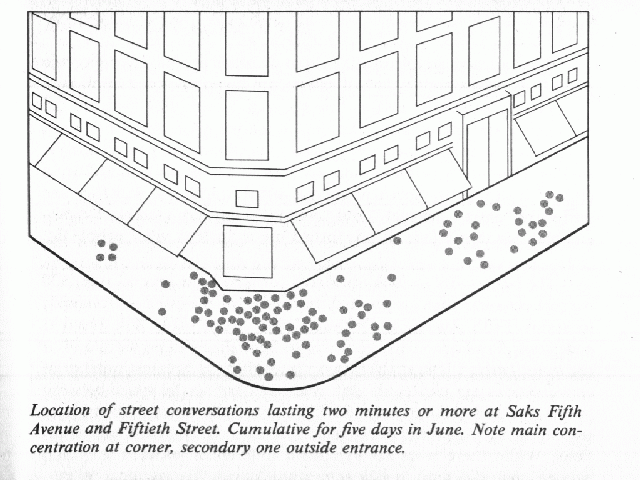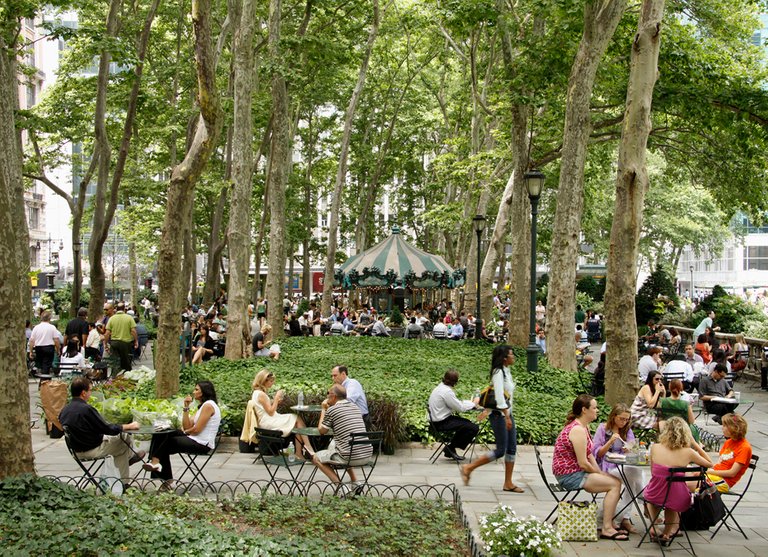
A New Look at Us in Cities
William H. Whyte might have been one of the most influential non-architects to transform the way we think about urban spaces all around us. He was a sociologist and writer of the 20th century, mostly concerned with the way corporations were run. But in the 1960s while he was working at the New York Planning Commission, he was tasked with understanding the behavior and nature of urban settings. So, he took the streets with video cameras and a documentation team.

Recording Seagram Building Plaza
The result of his on-the-ground research was a series of books dedicated to understanding the way we use our parks, plazas, streets, and every part of the open city and landscape. For us as designers, his most recognizable work was a classic film that came out of all this - The Social Life of Small Urban Spaces, 1988
In the film, Whyte records and narrates the way pedestrians use the city - how we congregate in plazas, how circulation works, how we react to certain elements like fountains and public benches, and all the other ways human nature plays out in our fabricated world.


Architecture has always leaned more towards art than science in recent decades and designers are more prone to concerning themselves with the quality of what they’re making. But William Whyte brought around a whole new sensibility of what design is by utilizing documentary film and a whole array of documentation techniques (surveys, workshops, etc.). Architecture was showcased as more of an observatory science so that we could finally start to understand the impact that architecture had on daily human activity and eventually mold the way we inhabit cities.
Applying a New Perspective
My profession as a landscape architect has been particularly impacted by the way Whyte has framed space. Much of design in our real is infrastructural or meant to host large groups of people and we’re less concerned with private areas for a select few. As such, we have to design with the quality of a larger audience and wider usership.
I believe that these concepts are important for any kind of making or design or creativity of course. We’re ultimately making for people and the ‘success’ of work will be determined by how those people use it. Rather than judging something based on aesthetics or reasoning, getting direct and indirect feedback by the public has been one of the most useful inputs for design professionals.

Bryant Park NYC 1991 courtesy Olin Studio
What do you think? Should all designers adopt this mentality?
Here you can watch the classic Willam Whyte's The Social Life of Small Urban Spaces.
@Mintvilla, an ever-learning landscape architect

I'm always surprised that more architects don't use video documentation to understand their and others' projects.
RIP William H. Whyte. What an incredible contribution to the design world.
I'm surprised too, it's definitely a tool we can all use more as designers.
High quality contents. Well written and arranged. Loved it.
Thank you greenrun!
@mintvilla Great Post, as usual.
Thank you @awillbrown!
Ayi larki main na apka post like ki Hai mujha ap upvote
Congratulations @mintvilla! You have completed some achievement on Steemit and have been rewarded with new badge(s) :
<p dir="auto"><a href="http://steemitboard.com/@mintvilla" target="_blank" rel="noreferrer noopener" title="This link will take you away from hive.blog" class="external_link"><img src="https://images.hive.blog/768x0/https://steemitimages.com/70x80/http://steemitboard.com/notifications/votes.png" srcset="https://images.hive.blog/768x0/https://steemitimages.com/70x80/http://steemitboard.com/notifications/votes.png 1x, https://images.hive.blog/1536x0/https://steemitimages.com/70x80/http://steemitboard.com/notifications/votes.png 2x" /> Award for the number of upvotes <p dir="auto">Click on any badge to view your own Board of Honor on SteemitBoard.<br /> For more information about SteemitBoard, click <a href="https://steemit.com/@steemitboard" target="_blank" rel="noreferrer noopener" title="This link will take you away from hive.blog" class="external_link">here <p dir="auto">If you no longer want to receive notifications, reply to this comment with the word <code>STOP <blockquote> <p dir="auto">By upvoting this notification, you can help all Steemit users. Learn how <a href="https://steemit.com/steemitboard/@steemitboard/http-i-cubeupload-com-7ciqeo-png" target="_blank" rel="noreferrer noopener" title="This link will take you away from hive.blog" class="external_link">here!Another way to ask the same question is, "Should social considerations be part of the design process?" Designers can have all sorts of intentions, whether purely aesthetic, ego-boosting, pragmatic, and/or to the benefit of people. I would guess that many designers are not ambitious/conscious enough to solve social problems with their work, even though that is the real impact of the spaces that we live in!
It's definitely a facet of design that hasn't taken a stage in design discourse. A lot of it is just simple naivety but some architects aggressively block these discussions from mainstream practice. It's a lot of hard work and complicated debate. Hopefully more practitioners take on these challenges.
Thanks for the comment Brian!
Congratulations @mintvilla! You have completed some achievement on Steemit and have been rewarded with new badge(s) :
<p dir="auto"><a href="http://steemitboard.com/@mintvilla" target="_blank" rel="noreferrer noopener" title="This link will take you away from hive.blog" class="external_link"><img src="https://images.hive.blog/768x0/https://steemitimages.com/70x80/http://steemitboard.com/notifications/voted.png" srcset="https://images.hive.blog/768x0/https://steemitimages.com/70x80/http://steemitboard.com/notifications/voted.png 1x, https://images.hive.blog/1536x0/https://steemitimages.com/70x80/http://steemitboard.com/notifications/voted.png 2x" /> Award for the number of upvotes received <p dir="auto">Click on any badge to view your own Board of Honor on SteemitBoard.<br /> For more information about SteemitBoard, click <a href="https://steemit.com/@steemitboard" target="_blank" rel="noreferrer noopener" title="This link will take you away from hive.blog" class="external_link">here <p dir="auto">If you no longer want to receive notifications, reply to this comment with the word <code>STOP <blockquote> <p dir="auto">By upvoting this notification, you can help all Steemit users. Learn how <a href="https://steemit.com/steemitboard/@steemitboard/http-i-cubeupload-com-7ciqeo-png" target="_blank" rel="noreferrer noopener" title="This link will take you away from hive.blog" class="external_link">here!William H. Whyte certainly opened up heads to design principals - I think you can go a few steps further even with time and intuition. keep breathing fresh air and making as many clean and relaxing spaces as you possible can. There will never be enough.
I am very interested in roof top development as green spaces in urban areas too. They seem to becoming increasingly popular thank goodness but there is sure space for a whole lot more.
Keep up the good work and keep us updated on your steempark!
Have a beautiful day!
Thank you for the support @sallybeth23! I have lots of updates surrounding STEEM Park and Herbert von King Park that I'll be sure to share in upcoming posts.
NYC definitely has some unique applications of rooftop green spaces and that's a great idea for some future research/posting. Thanks for the comment!